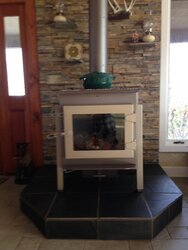A couple of months ago I posted on here about the arrival of my Ideal Steel. I think my post was Oct 7. Since then, I've burned at least a couple of cords in the stove, with mixed results. I talked to the nice salespeople at Woodstock, and they suggested I check with some of you in the forums who are using this stove.
Basically, I don't seem to be getting the heat production others are. Some background: I wouldn't consider myself an expert, but I've been heating my house in Wisconsin with wood almost exclusively for five years. My previous stove was a hearthstone homestead, which I loved, but was too small for my 2200 sq foot house. After reading this and other forums, I decided to go with the ideal steel, which is my first cat stove.
Just to get this out of the way, I'm now burning 1.5 yr c/s/s ash, along with some red elm and a little oak, all good dry stuff, even measured under 20 percent with a gadget. My draft was fine with my old stove, seems OK with this one.
When I engage my cat at about 300 or 350, many times the temp will sit, or even drop a little, after half an hour or so, at which time I open things up, and re-engage after I get more flame. I've done this dozens of times. Now quite tired of fooling with the stove, especially with these temps. I can't really afford to have the stove sit at 300 for an hour before it starts to heat up. My house temps plummets if I do.
Even when I am able to to engage the cat with some certainty, I'm still not getting the heat some report. I have a hard time getting the stove to 500 degrees, which is where I need it to be to heat my house. With my old stove, I would just keep adding splits. Can't do it with this one because it holds coals so well, the firebox would soon fill up with coals. I've really been trying to do complete burn cycles, but it's frustrating when my heat tops out at 425 and then drops off from that after a couple of hours. I've been keeping notes on the last few fires. I'm getting what I call useable heat (400 or above) for about 2-2.5 hours. The whole cycle for me, from 300 and back down to 300--lasts about 3.5-4.5 hours. This is no better than the little homestead. (Though I do have much better coal retention).
Any ideas? I'm very frustrated with the dozens (and dozens) of hours I've spent trying to get this thing dialed in.
Basically, I don't seem to be getting the heat production others are. Some background: I wouldn't consider myself an expert, but I've been heating my house in Wisconsin with wood almost exclusively for five years. My previous stove was a hearthstone homestead, which I loved, but was too small for my 2200 sq foot house. After reading this and other forums, I decided to go with the ideal steel, which is my first cat stove.
Just to get this out of the way, I'm now burning 1.5 yr c/s/s ash, along with some red elm and a little oak, all good dry stuff, even measured under 20 percent with a gadget. My draft was fine with my old stove, seems OK with this one.
When I engage my cat at about 300 or 350, many times the temp will sit, or even drop a little, after half an hour or so, at which time I open things up, and re-engage after I get more flame. I've done this dozens of times. Now quite tired of fooling with the stove, especially with these temps. I can't really afford to have the stove sit at 300 for an hour before it starts to heat up. My house temps plummets if I do.
Even when I am able to to engage the cat with some certainty, I'm still not getting the heat some report. I have a hard time getting the stove to 500 degrees, which is where I need it to be to heat my house. With my old stove, I would just keep adding splits. Can't do it with this one because it holds coals so well, the firebox would soon fill up with coals. I've really been trying to do complete burn cycles, but it's frustrating when my heat tops out at 425 and then drops off from that after a couple of hours. I've been keeping notes on the last few fires. I'm getting what I call useable heat (400 or above) for about 2-2.5 hours. The whole cycle for me, from 300 and back down to 300--lasts about 3.5-4.5 hours. This is no better than the little homestead. (Though I do have much better coal retention).
Any ideas? I'm very frustrated with the dozens (and dozens) of hours I've spent trying to get this thing dialed in.


